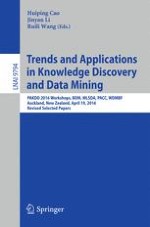2016 | Buch
Trends and Applications in Knowledge Discovery and Data Mining
PAKDD 2016 Workshops, BDM, MLSDA, PACC, WDMBF, Auckland, New Zealand, April 19, 2016, Revised Selected Papers
herausgegeben von: Huiping Cao, Jinyan Li, Ruili Wang
Verlag: Springer International Publishing
Buchreihe : Lecture Notes in Computer Science
